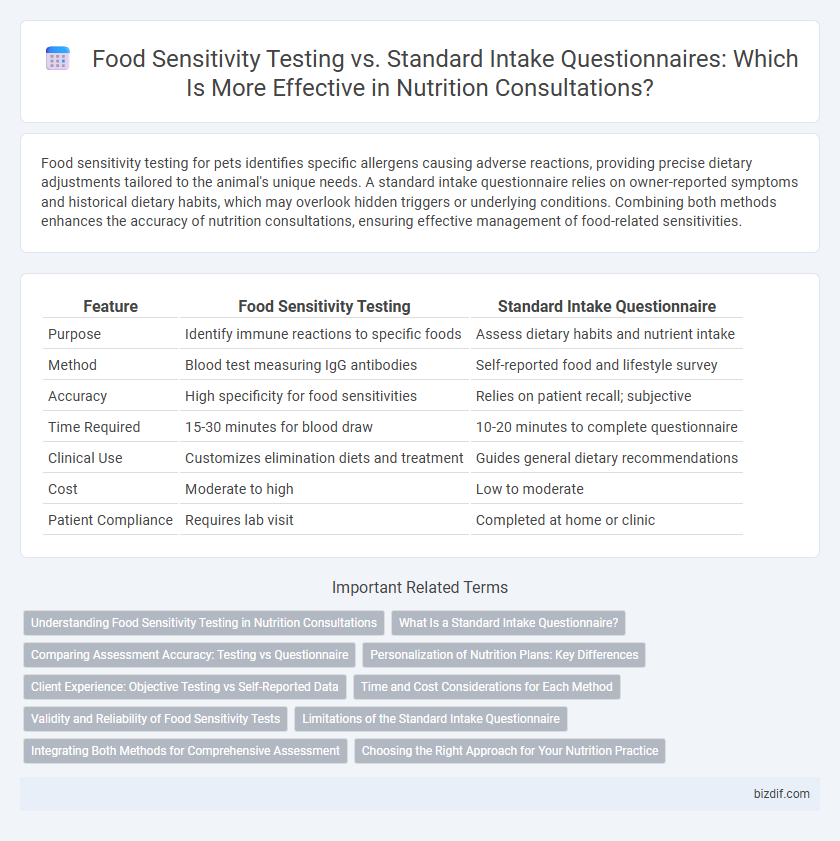Food sensitivity testing for pets identifies specific allergens causing adverse reactions, providing precise dietary adjustments tailored to the animal's unique needs. A standard intake questionnaire relies on owner-reported symptoms and historical dietary habits, which may overlook hidden triggers or underlying conditions. Combining both methods enhances the accuracy of nutrition consultations, ensuring effective management of food-related sensitivities.
Table of Comparison
| Feature | Food Sensitivity Testing | Standard Intake Questionnaire |
|---|---|---|
| Purpose | Identify immune reactions to specific foods | Assess dietary habits and nutrient intake |
| Method | Blood test measuring IgG antibodies | Self-reported food and lifestyle survey |
| Accuracy | High specificity for food sensitivities | Relies on patient recall; subjective |
| Time Required | 15-30 minutes for blood draw | 10-20 minutes to complete questionnaire |
| Clinical Use | Customizes elimination diets and treatment | Guides general dietary recommendations |
| Cost | Moderate to high | Low to moderate |
| Patient Compliance | Requires lab visit | Completed at home or clinic |
Understanding Food Sensitivity Testing in Nutrition Consultations
Food Sensitivity Testing identifies specific immune responses to certain foods, providing personalized insights beyond the general dietary patterns captured in Standard Intake Questionnaires. This testing helps nutrition professionals tailor elimination diets and nutritional interventions effectively, addressing symptoms that traditional questionnaires may overlook. Integrating Food Sensitivity Testing into nutrition consultations enhances accuracy in diagnosing food-related reactions and optimizing dietary recommendations.
What Is a Standard Intake Questionnaire?
A Standard Intake Questionnaire is a structured tool used during nutrition consultations to gather comprehensive information about a client's dietary habits, medical history, lifestyle, and food preferences. It helps nutritionists identify nutritional deficiencies, eating patterns, and potential areas for dietary improvement by capturing detailed data on meal frequency, portion sizes, and common food choices. This method contrasts with Food Sensitivity Testing, which focuses on identifying specific food intolerances or allergies through biochemical analysis rather than self-reported dietary information.
Comparing Assessment Accuracy: Testing vs Questionnaire
Food sensitivity testing offers objective measurement of immune responses to specific food antigens, providing precise identification of reactive foods that standard intake questionnaires may overlook due to self-reporting biases. Standard intake questionnaires rely heavily on patient recall and subjective symptoms, which can result in inaccurate or incomplete data, limiting their effectiveness in diagnosing food sensitivities. Combining both methods enhances assessment accuracy by validating subjective reports with biochemical data, leading to more personalized and effective nutrition interventions.
Personalization of Nutrition Plans: Key Differences
Food Sensitivity Testing identifies specific immune responses to certain foods, enabling highly personalized nutrition plans by targeting actual sensitivities rather than general recommendations. In contrast, Standard Intake Questionnaires rely on self-reported dietary habits and symptoms, which may underestimate hidden food intolerances and result in less precise dietary adjustments. Integrating food sensitivity data enhances customization and effectiveness of nutrition interventions compared to conventional intake assessments.
Client Experience: Objective Testing vs Self-Reported Data
Food sensitivity testing provides clients with objective, science-based results by analyzing biomarkers such as IgG antibodies, which reduces the reliance on subjective recall and potential biases common in self-reported data from standard intake questionnaires. Clients often find food sensitivity tests more precise and actionable, as these tests reveal specific immune responses to foods, whereas intake questionnaires depend heavily on memory and perception, leading to possible inaccuracies. Incorporating objective testing with intake questionnaires enhances personalized nutrition plans, improving client trust and dietary compliance through evidence-based insights.
Time and Cost Considerations for Each Method
Food Sensitivity Testing typically requires laboratory analysis that can take several days to weeks and often costs between $150 and $500, making it a more time-intensive and expensive option. Standard Intake Questionnaires are quicker to administer, usually completed within 15 to 30 minutes during a consultation, and generally cost less, ranging from $50 to $150 depending on the provider. Choosing between these methods depends on balancing the need for detailed, specific data from testing against the efficiency and affordability of questionnaires in nutrition consultations.
Validity and Reliability of Food Sensitivity Tests
Food sensitivity testing offers a more objective and scientifically measurable assessment compared to standard intake questionnaires, which rely heavily on self-reported data and may be influenced by recall bias. Validity studies of food sensitivity tests, such as IgG antibody assays, show varying results, with some demonstrating moderate correlation to clinical symptoms, whereas intake questionnaires lack standardized validation across diverse populations. Reliability of food sensitivity tests depends on the methodology used, with ELISA-based tests generally providing higher reproducibility than non-standardized questionnaires, which often yield inconsistent outcomes due to subjective reporting.
Limitations of the Standard Intake Questionnaire
The Standard Intake Questionnaire often lacks specificity in identifying underlying food sensitivities, as it relies heavily on self-reported symptoms and general dietary habits rather than objective biomarkers. This approach can result in overlooked or misdiagnosed food intolerances, leading to ineffective dietary recommendations and prolonged discomfort. Food Sensitivity Testing provides a more precise analysis by detecting immune responses to specific foods, enabling tailored nutrition plans that address individual sensitivities accurately.
Integrating Both Methods for Comprehensive Assessment
Integrating Food Sensitivity Testing with Standard Intake Questionnaires enhances the accuracy of identifying dietary triggers and nutrient imbalances by combining objective biomarker data with detailed client-reported eating habits. This comprehensive assessment enables nutrition consultants to tailor individualized dietary plans that address both physiological responses and behavioral patterns. Utilizing both methods facilitates a holistic understanding of a client's unique nutritional needs, promoting more effective interventions and improved health outcomes.
Choosing the Right Approach for Your Nutrition Practice
Food sensitivity testing identifies specific immune responses to various foods through blood or skin analysis, providing precise data to tailor nutrition plans for clients with adverse reactions. Standard intake questionnaires rely on self-reported dietary habits and symptoms, offering a broader overview of eating patterns but lacking biochemical validation. Integrating both methods can enhance accuracy, yet selecting the right approach depends on client needs, practice goals, and resource availability for personalized nutrition intervention.
Food Sensitivity Testing vs Standard Intake Questionnaire Infographic

 bizdif.com
bizdif.com